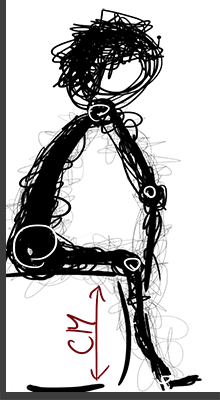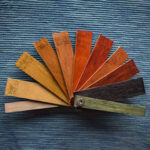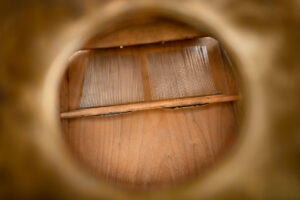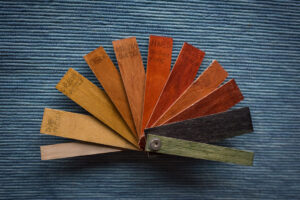What I offer:
- Custom production of cajons
- Repair of cajons of any brand – for example, cracked sound board, damaged snare or even greater damage
- Restoration of cajons – new resistant lacquer, sealing deep scratches, design change etc.
- Rent a cajon from my workshop
tailored custom-made cajons
Possible variations of instrument:
Cajon body:
Birch, plywood: resonant medium-hard wood – in my opinion, the most suitable cajon for an active musician who travels with him only occasionally. Optimal combination of sound quality vs. instrument weight.
Thickness:
10, 12, 15 or 18 mm
Poplar, plywood: soft resonant wood – suitable for a musician who travels frequently with an instrument. Also suitable for half cajons for children, who then carry it more easily. The weight is about 60% compared to birch, which can pleasantly lighten the caon to about 3 kg in adult size. The disadvantage is less resistance to mechanical damage and not very pronounced wood texture.
Thickness:
10 mm
Beech, plywood: hard, less resonant wood – suitable for the production of instruments that can withstand rough handling. At the same time, its sound will be very “fast”.
Thickness:
10 mm
Optional: of course you can go the other way. Spruce and pine plywood are also commonly available. I don’t mind working with solid wood. If you have your own resources, you can also use them.
Sound board:
- Birch, plywood: multi-layer plywood that is very resistant to cracking from thin dimensions. Optimal choice of sound quality vs. price.
Thickness:
1.5, 2, 2.5, 3 or 4 mm
Mahogany, plywood: a rarer material with a dense structure providing a pleasant sound with rounder highs, firm bass and stronger mids.
Thickness:
2.4 mm, others on request
Walnut: The tone of the walnut is warm compared to mahogany, with a well-audible center band and a long, balanced sustain.
Thickness:
2.4 mm, others on request
Cherry: wood with a beautiful texture, a unique color. They are harder and heavier, which also affects the character of the sound.
Thickness:
2.4 mm, others on request
Maple: acoustically brilliant and concrete with detailed highs, high mids and piercing bass. It has an unmistakable texture.
Thickness:
2.4 mm, others on request
Beech, plywood: less layered, but made of solid wood. The advantage is high resistance and thus greater durability. The blow has a very short reverberation.
Thickness:
3 or 4 mm
Snare wire
Cajon allows you to play a wide range of tones. From strong bass to high fast tones. The snare takes care of the specifically “rattling” sound of the cajon. It is stored roughly halfway between bass and treble. In fact, such midrange spectrum. The tunable snare wire therefore acts as an equalizer, especially in an enclosed space. By tuning it in correctly, you can emphasize the mids compared to other tones. At the same time, it will affect the speed of the sound board’s bounce when playing high tones with individual fingers (finger rolls), which an advanced player can greatly appreciate. The string can also be fully deactivated for quiet percussion accompaniment of other instruments.
- For my cajons, the string is adjustable as standard, as I consider it an absolutely indispensable feature. The controls are on the side of the cajon and can be easily changed quickly while playing.
- The number of strings on the snare wire: affects the strength of the string pressure and also the intensity of the “rattle” in the overall sound of the cajon.
There are 20, 30 or 40 strings to choose from
- For children’s cajons, the snare wire is fixed, the adjustable can be mounted on request
Colors
In order to be a truly cajon, of course, it must also have the color that is your favorite 🙂
- Each type of wood has its own specific shade, which is further subtly influenced by the choice of varnish or oil used.
- I use alcohol stains to significantly color the wood, which can significantly change the natural appearance of the wood and at the same time leave its beautiful drawing.
- There is a wide range to choose from: walnut, mahogany, chestnut, cedar, oak, rosewood, greenery, blue, black and more. The range is really wide. You can also choose a combination of colors. Each individual part of the cajon can be painted individually.
Basic overview of stains on birch wood:
Size
The size can be chosen completely arbitrarily. In my opinion, it is very important to adjust the instrument accordingly, especially according to the height of the player’s figure. This will guarantee the correct position of the body when playing, which will allow you to easily reach the individual types of beats (especially bass) and ensure comfort for the back, which you will know especially when playing for longer.
The depth of the cajon affects the total volume of the instrument and thus especially the intensity of the bass. The default is 30 cm for the adult version.
I will need the following information for the exact settings:
Height of cajon

Snare wire placement

Lean your back against the wall so that your thighs and calves are at right angles. Measure the distance of the buttocks from the ground.
Measure the distance from the middle of the second middle finger joint to its end.
Design
The range of colors can be supplemented with special design elements such as drawings with acrylic paints or burning with solder into wood. Themes are optional. The customer can create the cajon drawing himself and I will then finish the surface treatment.
By default, the logo is burned on the cajon (see page header). And on the front plate and in the back of the cajon.
Cover
On request, the cajon can be delivered in a beautiful hand-sewn transport cover from the seamstress Zuzka. You can choose from an almost unlimited amount of solid fabrics and designs. The look can be made entirely according to your wish. Or just let Zuzka creatively tune the cover according to the look of the cajon and your personal style.
I recommend all clients to buy it, right at the beginning because it is unexpectedly easy to make a hole in the cajon 🙂 In addition, this will significantly extend the life of the tool with respect to wood, which likes to stay dry as much as possible.
The backpack has adjustable back straps for maximum comfort when carrying (our customers even ski with them 🙂
Price
It depends, of course, on the complexity of production, the price of the material and specific requirements. The variance is quite wide from 100 to 300 €. It is therefore always best to meet, call or write and together find the best variant of performance / appearance / price.


























